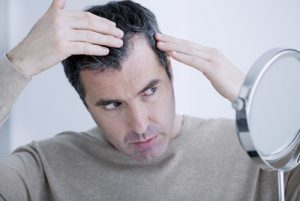New research published in the journal Proceedings of the National Academy of Sciences shows key molecular events that occur with hair growth in mice. A team of scientists from the University of Southern California in Los Angeles transplanted a special type of cell, called progenitor cells, into hairless mice and then observed how the cells reacted. They discovered that hair development and growth is a six-step process, and they used this knowledge to stimulate hair growth in adult mice. 
The researchers believe this discovery has the potential for use in adults with conditions like alopecia or male-pattern baldness.
Treating Hair Loss
Dr. Ahvie Herskowitz, founder of San Francisco Stem Cell Treatment Center, uses stem cell therapy as a treatment option for those with baldness and other hair loss-related conditions.
“We use adult stem cells that can be taken directly from the fat cells of the patient and then reintroduce them to help stimulate hair growth,” he said. “These cells are rich in growth factors, and the procedure is simple and quick.”
Stem cell treatment for hair loss is still in its early stages, but many doctors are using it to offer patients an alternative method of treatment, especially for those who have been told surgery is the only option. The treatment involves removing stem cells from the patient’s fat, then processing and separating them from the fat cells. Then, using local anesthesia, the stem cells are injected into the scalp.
How Stem Cells Work
Adult stem cells, such as those used in Herskowitz’s practice, are thought to be effective because they can renew themselves and become many different types of cells. In fact, that’s the very definition of a stem cell. To be classified as a stem cell, the cell must have the ability to make copies of itself and become many different kinds of cells.
“Our bodies have these cells waiting and ready to repair any tissue that should become damaged,” said Herskowitz. “By removing the cells and moving them to an area we need them to begin repairing, we stimulate the regenerative process naturally.”
Adult stem cells have been discovered in many of the body’s organs and tissues, including the brain, bone marrow, blood vessels, muscles, skin, teeth, heart, stomach and liver. Disease or injury to the tissue usually stimulates these cells into action, and they begin regenerating and repairing where needed. More research is being done on these cells to discover just how they work and how they can help treat conditions that are currently incurable.
Treating Other Health Issues
Doctors such as Herskowitz are studying the use of stem cells for treating many diseases including diabetes, lupus, osteoarthritis, rheumatoid arthritis, stroke, dementia, Alzheimer’s, heart disease, Parkinson’s, multiple sclerosis, erectile dysfunction and many more.
“The anti-inflammatory and potential regenerative properties of stem cell therapy may offer recovery from many diseases we have yet to find successful treatment for,” said Herskowitz.
